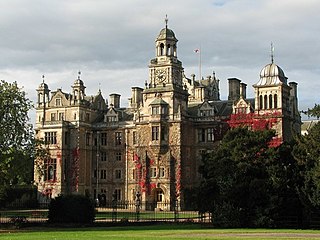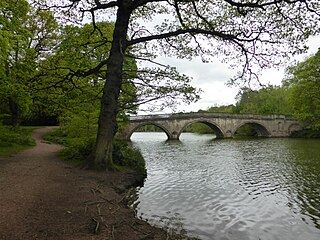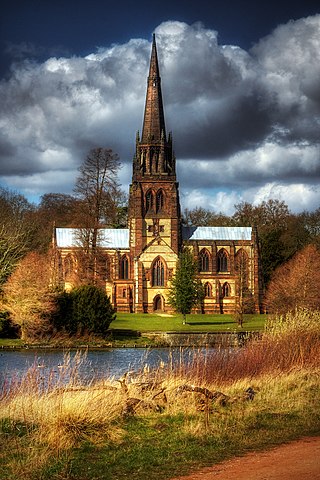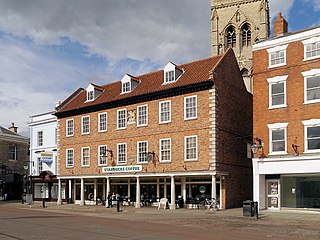
Sherwood Forest is the remnants of an ancient royal forest in Nottinghamshire, England, having a historic association with the legend of Robin Hood.

Nottinghamshire is a ceremonial county in the East Midlands of England. The county borders South Yorkshire to the north-west, Lincolnshire to the east, Leicestershire to the south, and Derbyshire to the west. The largest settlement is the city of Nottingham (323,632).
Duke of Newcastle upon Tyne was a title that was created three times, once in the Peerage of England and twice in the Peerage of Great Britain. The first grant of the title was made in 1665 to William Cavendish, 1st Marquess of Newcastle upon Tyne. He was a prominent Royalist commander during the Civil War.

Worksop is a market town in the Bassetlaw District in Nottinghamshire, England. It is located 15 miles (24 km) south of Doncaster, 15 miles (24 km) south-east of Sheffield and 24 miles (39 km) north of Nottingham. Located close to Nottinghamshire's borders with South Yorkshire and Derbyshire, it is on the River Ryton and not far from the northern edge of Sherwood Forest. Other nearby towns include Chesterfield, Gainsborough, Mansfield and Retford. The population of the town was recorded at 44,733 in the 2021 Census.

Wimpole Estate is a large estate containing Wimpole Hall, a country house located within the civil parish of Wimpole, Cambridgeshire, England, about 8+1⁄2 miles southwest of Cambridge. The house, begun in 1640, and its 3,000 acres (12 km2) of parkland and farmland are owned by the National Trust. The estate is regularly open to the public and received over 335,000 visitors in 2019. Wimpole is the largest house in Cambridgeshire.

The River Poulter which rises near Scarcliffe in Derbyshire, England is a tributary river of the River Idle in Nottinghamshire. It supplied power to mills along its route, most of which are now gone, although their mill ponds remain. Cuckney mill building is used as a primary school. The river has been dammed to create several lakes in the Dukeries estates of Welbeck Abbey and Clumber House now the National Trust property of Clumber Park. The ornamental Gouldsmeadow Lake, Shrubbery Lake and Great Lake on the Welbeck estate are supplied by a tributary of the Poulter, while Carburton Forge Dam and Carburton Dam were built to power a forge and a mill. Clumber Lake, consisting of an upper and lower lake, which is spanned by a Grade II* listed ornamental bridge, is part of the Clumber estate, and has suffered from subsidence.

Cannon Hill Park is a park located in south Birmingham, England. It is the most popular park in the city, covering 250 acres (101 ha) consisting of formal, conservation, woodland and sports areas. Recreational activities at the park include boating, fishing, bowls, tennis, putting and picnic areas.

The Dukeries is an area of the county of Nottinghamshire so called because it contained four ducal seats. It is south of Worksop, which has been called its "gateway". The area was included within the ancient Sherwood Forest. The ducal seats were:

Henry Fiennes Pelham-Clinton, 2nd Duke of Newcastle-under-Lyne, KG, PC was born in London, the second son of the 7th Earl of Lincoln.

Henry Cavendish, 2nd Duke of Newcastle upon Tyne, KG, PC, styled Lord Henry Cavendish until 1659 and Viscount Mansfield from 1659 to 1676, was an English politician. He sat in the House of Commons from 1660 until 1676, when he inherited the dukedom.

Welbeck Abbey is an English mansion situated in the village of Welbeck, which is within the civil parish of Norton, Cuckney, Holbeck and Welbeck, in the Bassetlaw District of Nottinghamshire. It was the site of a monastery belonging to the Premonstratensian order in England and after the Dissolution of the Monasteries, a country house residence of the Dukes of Portland. It is part of the Dukeries, four contiguous ducal estates in North Nottinghamshire. The house is a Grade I listed building.

Henry Pelham Fiennes Pelham-Clinton, 4th Duke of Newcastle-under-Lyne was a British nobleman and politician who played a leading part in British politics in the late 1820s and early 1830s. He was styled Lord Clinton from birth until 1794 and Earl of Lincoln between 1794 and 1795.

Worksop Manor is a Grade I listed 18th-century country house in Bassetlaw, Nottinghamshire. It stands in one of the four contiguous estates in the Dukeries area of Nottinghamshire. Traditionally, the Lord of the Manor of Worksop may assist a British monarch at his or her coronation by providing a glove and putting it on the monarch's right hand and supporting his or her right arm. Worksop Manor was the seat of the ancient Lords of Worksop.

Carburton or Carberton is a small village on the west side of Clumber within the Bassetlaw district of Nottinghamshire, England. It is primarily rural and residential. The church of Saint Giles is an unusual shape and dates back to the early 12th century, parish records date back to the 1530s

The Church of St. Mary the Virgin, Clumber Park, is an Anglican church in Clumber Park, Nottinghamshire, England.

St Luke's Church, Shireoaks is a Grade II listed Church of England parish church in Shireoaks, Nottinghamshire.

Clumber and Hardwick is a civil parish in the Bassetlaw district, in the county of Nottinghamshire, England. The parish includes the settlement of Hardwick Village and Clumber Park, a country park. In the UK census of 2021 the parish had a population of 66. The parish lies in the north west of the county, and south west within the district. It is 125 miles north west of London, 22 miles north of the city of Nottingham, and 3½ miles south east of the market town of Worksop.The parish touches Babworth, Carburton, Elkesley, Perlethorpe cum Budby and Welbeck. The parish was formed on 1 April 1994. The area is within Sherwood Forest and has close historical associations with the Dukes of Newcastle, being part of a wider region known as The Dukeries. There are 26 listed buildings in Clumber and Hardwick.

St Marys Church is a Roman Catholic parish church in Worksop, Nottinghamshire, England. It was built from 1838 to 1840 by Weightman and Hadfield in the Gothic Revival style. It is located on Park Street to the south of the town centre. It was paid for by Bernard Howard, 12th Duke of Norfolk after the sale of Worksop Manor and was once visited by Archduke Franz Ferdinand. It is a Grade II listed building.
Clumber and Hardwick is a civil parish in the Bassetlaw District of Nottinghamshire, England. The parish contains 26 listed buildings that are recorded in the National Heritage List for England. Of these, one is listed at Grade I, the highest of the three grades, six are at Grade II*, the middle grade, and the others are at Grade II, the lowest grade. The parish contains Clumber Park, the grounds of the former Clumber Park House, and the settlement of Hardwick Village. The listed buildings in Clumber Park include the surviving range of the house, the stable range, a stable courtyard and former vicarage, the kitchen gardens and a palm house, a church, a bridge, two temples, a grotto, gateways and lodges. In the village are houses, farm buildings and a war memorial.

The Moot Hall is a municipal building in the Market Place in Newark-on-Trent, Nottinghamshire, England. The building, which was the main municipal building in the town in the 18th century, currently accommodates a Starbucks coffee shop.
























